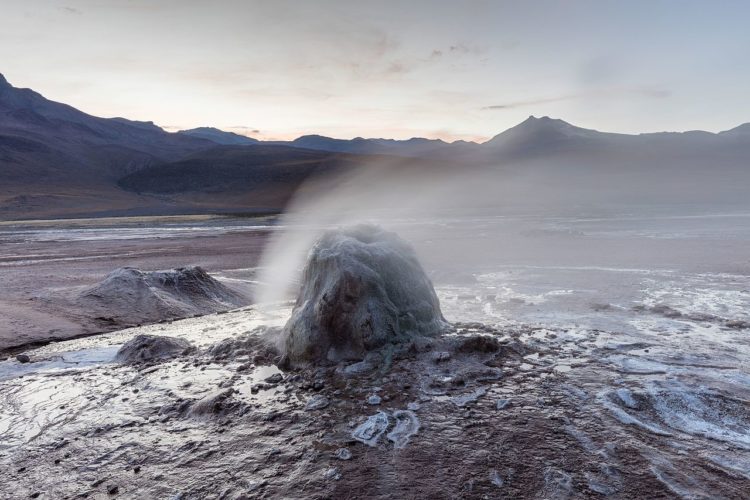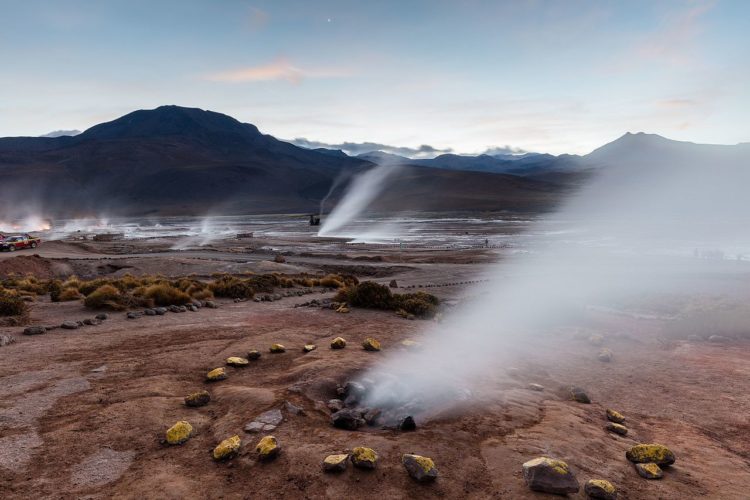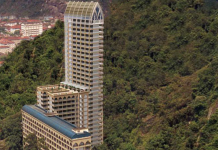El Tatio is a geyser field located within the Andes Mountains of northern Chile, along the border with Bolivia. Before the sun starts to rise, in the early morning, more than 60 geysers, hot springs, mud pools, mud volcanoes, and many fumaroles spew hot waters and steam. The largest geyser in the southern hemisphere is 4.320 meters above sea level.
El Tatio is also the third-largest geyser field in the world (after Yellowstone in the U.S. and the Valley of Geysers on the Kamchatka Peninsula in Russia) and covers an area of 12 square miles, seeping steam across its surreal expanse. The stratovolcanoes that surround the dreamy, high-altitude El Tatio geyser field, which is a component of the nearby geothermal system, are a sight to behold.
Geothermal power is the energy that comes from the internal heat of the Earth, and where the heat flow from the interior of the globe is sufficiently high, it can be used both for heating purposes and for the generation of electrical power. El Tatio has extremophile microorganisms, which is possible analogous example of life on early Earth and potential past life on Mars.
The exclusive environment of El Tatio “provides a better environmental analog for Mars than those of Yellowstone National Park and other well-known geothermal sites on Earth.” Depending on the season, the hot springs yield 0.25–0.5 cubic meters per second of water at temperatures reaching the local boiling point. The Chilean government and private companies are looking at the idea of harnessing geothermal energy but could not succeed due to El Tatio’s remote location and environmental concerns that have stalled any geothermal power projects.
In 2010, the site was declared a protected area; however, tourism remains the main business at El Tatio. The El Tatio geyser field is also known as the Copacoya geysers. The first geothermal prospecting of the field occurred in the 1920s, particularly in cold weather. The field once numbered 67 geysers and more than 300 hot springs, as some geyser fountains reached heights of over 10 meters; usually, they do not exceed 1 meter.
The hydrothermal activities are the main reason for discoloring the several volcanoes in the El Tatio volcanic group. El Tatio is a tourism destination, with substantial amounts of travelers both from Chile and other countries playing an integral part of an economic resource for the region, as more than 400 daily visitors come here to see these exclusive geysers.
The water is rich in minerals, especially sodium chloride, rubidium, strontium, bromine, magnesium, cesium, lithium, arsenic, sulfate, boron, potassium, silica, and calcium. Hydrothermal alteration at El Tatio has also yielded large deposits of alteration minerals such as illite, nobleite, smectite, teruggite, and ulexite.
Moreover, El Tatio and a number of other geothermal fields have been dominated by andesitic volcanism producing lava flows until the late Miocene, when large-scale ignimbrite activity took place between 10 and 1 million years ago. Toxic minerals like arsenic pollute the water in this area, causing health issues for the population.
The climate is dry, falling between December and March, and rather windy, which influences the hot springs by enhancing evaporation. This region has extreme temperature variations between day and night. El Tatio lies at a high altitude, regularly leading to altitude sickness, and the cold, dry climate creates further danger.
Further El Tatio area exposure to hot gases and water can result in burn injuries, and both sudden eruptions of geysers and fountains and the fragile ground above vents and boiling water, concealed beneath thin covers of solid ground, increase the risk to unwary travelers.
The permeability of the volcanic material controls the hot spring fluids that seep into the earth southeast and east of El Tatio. Unlike geothermal fields in wetter parts of the world, given the dry climate of the area, local precipitation does have little influence on the hot spring hydrology at El Tatio. The time it takes for the water to traverse the whole path from precipitation to the springs is about 15 years.
The water travels through a number of aquifers, which correspond to permeable rock formations through faults and fractures in the rock. Magmatic brine is mixed into this water, and the mixture ultimately becomes the water that emerges at El Tatio. This area of dry grassland vegetation is tussock grasses like Anatherostipa, Festuca, and Stipa while rosette and cushion plants are Azorella, Chaetanthera, Mulinum, Senecio, Lenzia, Pycnophyllum, and Valeriana.
El Tatio geyser field is one of San Pedro de Atacama’s most popular surrounding attractions, so don’t miss it whenever you go to Chile. The natural marvels at the geothermal wonders provide breathtaking views for taking pictures.
Also, read about Mount Danxia! World Famous UNESCO Geopark of China









Source: Atlas Obscura ! Wikipedia






